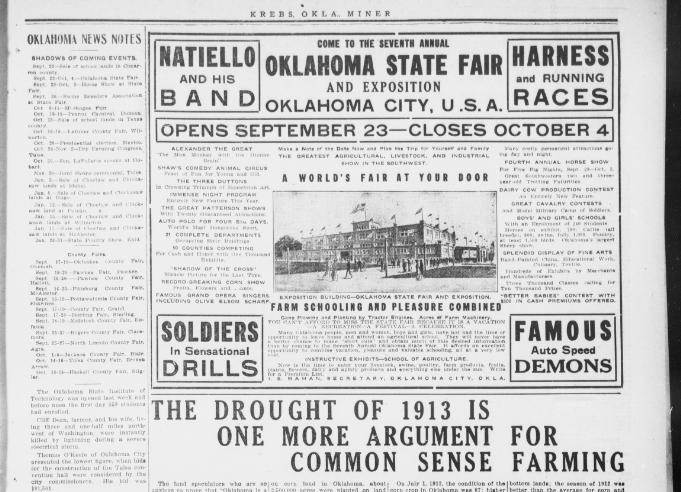|
Moderated by NW Okie! |
Volume 14 , Issue 342012Weekly eZine: (366 subscribers)Subscribe | Unsubscribe Using Desktop... |
The Drought of 1913

It was September 18, 1913, in The Oklahoma Miner, located in Krebs, Pittsburg county (southeastern corner of the state), Oklahoma, that we find on page three the headlines "The Drought of 1913 Is One More Argument For Common Sense Farming."
Back in 1913 there were land speculators who were so anxious to prove that Oklahoma was a great corn country and regularly defeated their own purpose by planting large acreages to corn on land totally unsuited to the crop. It was on July 1, 1912, the conditions of the corn crop in Oklahoma was 90; higher than any other state. But in August, 1912 it dropped to 65; lower than any other state. The average condition of corn in Oklahoma on August 1, during a period of ten years, was 76. The only one state, Texas, was lower with an average condition of 73.
These figures were the figures sent out by the Bureau of Statistics of the U.S. Department of Agriculture. Businessmen all over the country used them as a basis for forming their opinion of Oklahoma as an agricultural state. They were official figures and they could not be offset by wild statements in boosting dope which may be spread broadcast.
There was reported in 1913 a lot of good corn in Oklahoma, perhaps 3 million acres which had a condition of 80 on August 1, 1913.
But in addition to the corn planted on corn land in Oklahoma about 2,500,000 acres were planted on land and under conditions not at all suited to the production of a profitable corn crop. The poor condition of this large area offset the good condition of the rest and put into the permanent records of the government a report on the condition of corn in Oklahoma on August 1, 1912, which would indicate to those who do not understand all of the facts, that Oklahoma was not a corn country at all.
It was reported in 1913 that it was time to stop this sort of foolishness. Not only had the effort to prove that "Oklahoma was a great corn country" failed to fool anyone; it had brought about official reports which lead the uninformed to believe that corn was unprofitable on all lands in Oklahoma.
It was also reported that land that had failed to produce at least 25 bushels of good corn to the acre should not be planted to corn again. They were wanting to limit the corn acreage to real corn lands so that Oklahoma may get full credit among the rest of the states for what it really does in the way of the profitable production of corn.
They were telling farmers the following suggestions to "Farm by a Safe System" which John Fields, H. M. Cottrell and the bankers had been urging upon the farmers in every possible way, would, if they had been adopted in 1913, have averted much of the disaster which had come upon us.
There was a system of farming, based upon experience and experiment in Oklahoma, where rainfall is always variable and often deficient, and where strong winds and high summer temperatures produce conditions unknown to farmers of the Northern and Atlantic Coast states, has been developed and should be adopted by all farmers.
The general plan of operation was based on the following:
- Corn should be planted only on bottom lands; the season of 1912 was better than the average for corn and land which did not yield more than 25 bushels of corn to the acre in 1912 should hereafter be planted to kafircorn.
- Every acre of rich, well-drained bottom land which does not overflow frequently or for long periods of time should be put to alfalfa as soon as possible.
- The smooth, tillable uplands and prairies should never be planted to corn. They should instead be planted to kafircorn or milo maize for a sure crop of grain for feed and sale, and for filling silos and providing rough feed; to cowpeas and peanuts for feed and forage and soil improvement; and to cotton, wheat, oats, and broomcorn for cash crops, wherever soil and climate are suitable.
- The washy soils, hillsides, rough places, alkali lands, and overflow bottoms should be set to hardy bermuda grass, wherever this grass thrives.
- Those who follow a general system of farming such as this, and feed most of their crops to good livestock, will be the ultimate owners of all the good farms in Oklahoma.
| © . Linda Mcgill Wagner - began © 1999 Contact Me | |
